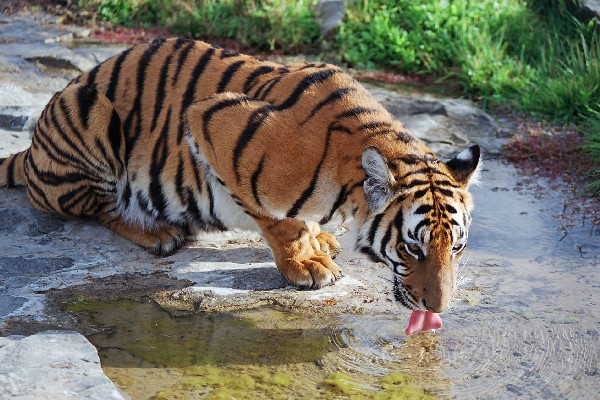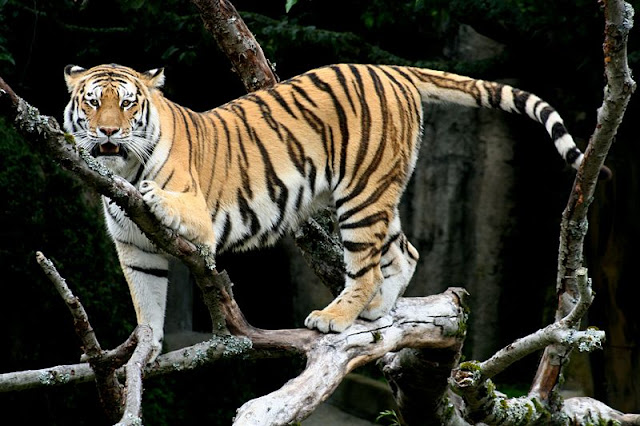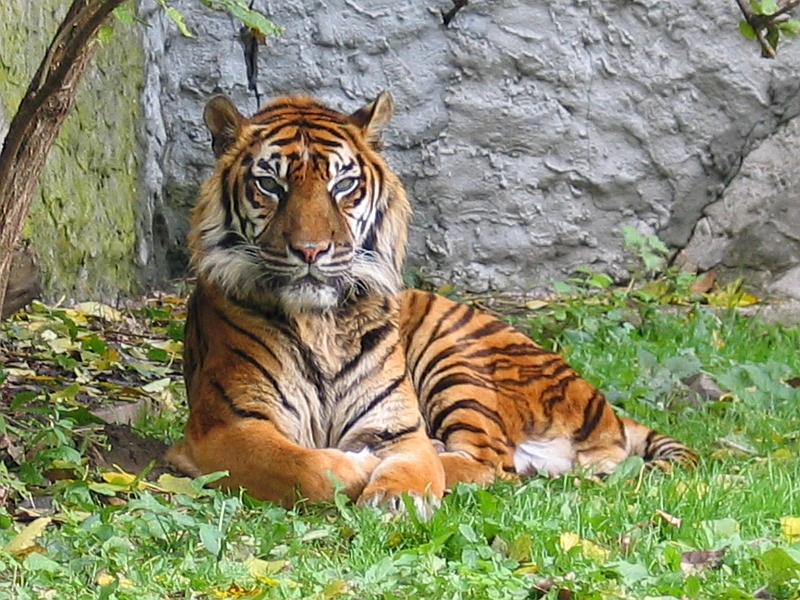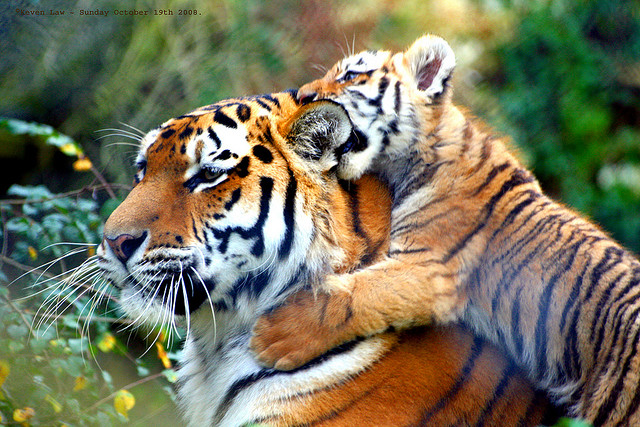
1. Illegal killing, or poaching
- a. Tigers have been legally protected from hunting in all countries of their range, except Burma, since the late 1970s. b. Tigers are illegally shot and poisoned mainly for two reasons: their threat (or perceived threat) to domestic wildlife or people, and most commonly, for monetary gain. (4)
c. Illegal killing is difficult to control. Poaching networks are well organized, and countries in which tigers live often don't have the resources to hire, equip, and train law enforcement officers.
- (1) In the past, tigers were poached primarily for furs. Though furs are still sold illegally, their market has been reduced due to public campaigns against furs and international trade controls. (2) Currently, tigers are poached mainly for their bones and other body parts. Tiger bones, which are relatively easy to smuggle, are used primarily by the Chinese in a variety of medicinal products. (3) Because tigers in China have been virtually exterminated, tigers in other countries are heavily poached to meet the demand for bones. Deer and other prey items are also poached, which reduces the tiger's food supply.
2. Loss of habitat.
- a. Tigers are losing habitat due to the needs of Asia's rapidly growing human population. In India alone, the human population has increased by nearly 50% since 1973, and the total population in 1995 is estimated to be about 931 million. (4, 17) b. Prime tiger habitat, such as forests and grasslands, are being converted to agriculture and settlements. Between 1980 and 1990 in Asia, about 470,000 square km (181,467 square mi.) of moist forest were destroyed. Deforestation is predicted to continue at a rate of 47,000 square km (18,147 square mi.) per year. (4) c. Tiger habitat is also declining due to intrusion of grazing domestic livestock, collection of wood for fuel and building materials, and mining. These activities are often done illegally in tiger reserves. d. Tigers need large, interconnected tracts of suitable habitat to maintain healthy breeding populations. Because they won't cross open land, the conversion of their habitat causes populations to become isolated from one another. In smaller, isolated populations, related tigers tend to mate, causing genetic inbreeding. In addition, competition for resources and mates is increased, which may lead to more aggressive, fatal encounters between tigers.

The tiger (Panthera tigris), a member of the Felidae family, is the largest of the four "big cats" in the genus Panthera. The tiger is native to much of eastern and southern Asia, and is an apex predator and an obligate carnivore.

Tigers have a lifespan of 10–15 years in the wild, but can live longer than 20 years in captivity. They are highly adaptable and range from the Siberian taiga to open grasslands and tropical mangrove swamps.
Historically, tigers have existed from Mesopotamia and the Caucasus throughout most of South and East Asia.
The oldest remains of a tiger-like cat, called Panthera palaeosinensis, have been found in China and Java. This species lived about 2 million years ago, at the beginning of the Pleistocene, and was smaller than a modern tiger. The earliest fossils of true tigers are known from Java, and are between 1.6 and 1.8 million years old. Distinct fossils from the early and middle Pleistocene were also discovered in deposits from China, and Sumatra. A subspecies called the Trinil tiger (Panthera tigris trinilensis) lived about 1.2 million years ago and is known from fossils found at Trinil in Java.

There are nine recent subspecies of tiger, three of which are extinct. Their historical range (severely diminished today) ran through Bangladesh, Siberia, Iran, Afghanistan, India, China, and southeast Asia, including some Indonesian islands. The surviving subspecies, in descending order of wild population, are:

The Bengal tiger or the Royal Bengal tiger (Panthera tigris tigris) is the most common subspecies of tiger and is found primarily in India and Bangladesh.
The Indochinese Tiger (Panthera tigris corbetti), also called Corbett's tiger, is found in Cambodia, China, Laos, Burma, Thailand, and Vietnam. These tigers are smaller and darker than Bengal tigers.
The Malayan Tiger (Panthera tigris jacksoni), exclusively found in the southern part of the Malay Peninsula, was not considered a subspecies in its own right until 2004.
The Sumatran Tiger (Panthera tigris sumatrae) is found only on the Indonesian island of Sumatra, and iscritically endangered. It is the smallest of all living tiger subspecies.
The Siberian tiger (Panthera tigris altaica), also known as the Amur, Manchurian, Altaic,Korean or North China tiger, which is the most northernmost subspecies, is confined to the Amur-Ussuri region of Primorsky Krai and Khabarovsk Krai in far eastern Siberia, where it is now protected. The Amur tiger is also noted for its thick coat, distinguished by a paler golden hue and fewer stripes.
The South China Tiger (Panthera tigris amoyensis), also known as the Amoy or Xiamen tiger, is the most critically endangered subspecies of tiger and is listed as one of the 10 most endangered animals in the world.
Extinct subspecies
The Bali Tiger (Panthera tigris balica) was limited to the island of Bali. They were the smallest of all tiger subspecies.
The Javan tiger (Panthera tigris sondaica) was limited to the Indonesian island of Java.
The Caspian Tiger (formerly Panthera tigris virgata), also known as the Persian tiger or Turanian tiger was the westernmost population of Siberian tiger, found in Iran, Iraq, Afghanistan, Turkey, Mongolia, Kazakhstan, the Caucasus,Tajikistan, Turkmenistan, and Uzbekistan until it apparently became extinct in the late 1950s.





1. Tigers are important biologically to maintain the overall health of an ecosystem. As a top predator of the food chain, tigers help keep prey populations in check.
2. Tigers also have cultural importance. Tigers have symbolized beauty, power, and fierceness for over 5,000 years. In Asia, tigers have been identified with gods and considered conquerors of evil. Ironically, the belief that tigers hold great power, even in their bones, is leading to their decline.
3. Large, familiar animals such as tigers are often times the species that act as mediating elements, generating funds and action for habitat preservation. The loss of these symbolic cats could lead to a decline of support in maintaining their ecosystems, and consequently, all of the other plant and animal species that share it.

A region the size of the U.S. state of Vermont has been earmarked by Myanmar as a sanctuary for the tiger, one of the most endangered animals on the planet.
The entire Hukaung Valley is to be declared a Protected Tiger Area, the government of Myanmar announced, according to two conservation organizations which do extensive work in the country, Panthera and Wildlife Conservation Society.








No comments:
Post a Comment